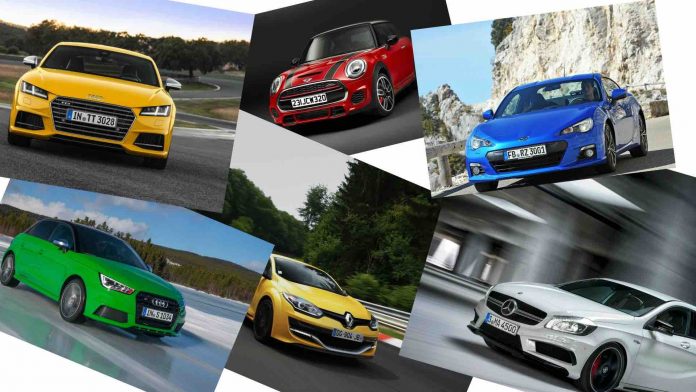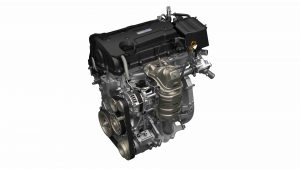There’s an interesting parallel between the effort to Face Diaper America and the effort to bolt a turbocharger to everything on wheels – including vehicles that have no more need for a turbo than a healthy person has for a dirty old bandana festooned over his face.
Both are being pushed on the public by proxies. The Diapers, by privately owned businesses – which have become adjuncts of the government, but without elections. The turbos – also by private businesses – and for similar reasons.
The government waves its conductor’s baton – the businesses play the tune. You don’t get a say.
Pop the hood of almost any new car and you will find a turbocharged engine. They are fast becoming the standard engine, even in bread-and-butter models like the 2020 Honda CR-V, which will be the focal point of this article because it represents this weird trend of turbocharging transportation appliances rather than (as in the past) high-performance cars.
There’a a reason for this, which we’ll get into shortly. First, some background.
Like a large and growing number of new cars, the ’20 CR-V no longer offers an engine without a turbocharger. Its previously standard 2.4 liter engine has been dropped and in its place, a 1.5 liter engine – with a turbo – is standard across the line.
The 1.5 liter engine makes about the same power (190 hp) as the no-longer-available 2.4 liter engine, which made 184 hp. But it is a much smaller engine – with a turbo bolted to it to make up for the loss of displacement. You pay $600 more for this up front – the difference in the base price of 2020 with the 1.5 ($25,050) vs. the 2019 with the 2.4 ($24,450).
And you may pay a lot more at some point down the road – because the 1.5 engine has to work harder to make its power – and because it has more parts that could fail, such as the turbo and the related peripherals.
Honda can usually be counted on for top-shelf engineering work but the fact remains that turbocharged small engines are more complex and under more stress (pressure, literally) than larger engines without turbos that make approximately the same power.
There is a reason why turbos used to be used almost exclusively as power-adders in high-performance cars and were rarely, if ever, found in cars meant to be daily driven/family cars. People who buy high-performance cars understand the trade-off (more power for more money and probably less reliability) and willingly buy in.
Today, turbos are being used for an entirely different reason – and it’s very hard to opt out.
They are displacement replacers – bolted on to make up for lost power caused by making engines smaller, in order to make them use less gas.
The idea is that the small engine will do just that most of the time – because it’s smaller. But when the driver needs more power – expressed by his pushing down on the gas pedal – the turbo will “spool up” (i.e., produce boost, stuff the cylinders with more air than they could inhale on their own) and the engine will make more power than it otherwise would – temporarily, for only as long as the driver needs it.
When he doesn’t, the engine goes back to being small – and having a smaller appetite.
It sounds good, right?
But, there is a cost – or rather, a shifting of cost. The car’s manufacturer can tout a gas mileage increase (in fact, the increase is more to placate the federal government, which decrees mandatory MPG minimums all car companies must “comply” with else be fined, those fines passed on to you, the buyer, in the form of more expensive cars) but you pay an increased MSRP – as in our example of the $600 increase in the base price of the otherwise-the-same 2020 Honda CR-V vs. the 2019.
At the current roughly $2 per gallon for regular unleaded, that $600 you just spent to save on gas could have bought about 300 gallons of gas. The 2019 CR-V with the 2.4 liter engine and no turbo can travel 31 miles on a gallon of gas (highway). That’s about 9,300 miles of driving – or rather, about 9,300 miles of driving before you reach par vs. the buy-in cost of the 2020 with the 1.5 liter engine.
Which averages 34 on the highway.
And the turbo’d ’20 may cost you more more down the road, too. For repair work. To fix things that can’t break if you didn’t own the turbocharged engine, because the non-turbocharged engine doesn’t have the turbo (and intercooler and other specialized parts) and because it doesn’t have to work under as much pressure to make the same power.
Which brings up the other cost – or rather, the con.
Nominally, the turbo’d ’20 will deliver 3 more miles per gallon on the highway and three more miles per gallon in city driving (28 MPG vs. 25 MPG for the ’19 with the 2.4 liter engine).
But will it actually deliver on those numbers?
Not on the government’s test loops – which is how the numbers are arrived at – but out in the real world, with you behind the wheel?
The problem with the idea of a downsized engine with a turbo to make up for the power lost by making it smaller is that you have to use the boost to make up for that loss of power. In other words, you’re only likely to see the touted mileage improvement if you don’t expect equivalent performance vis-a-vis the same vehicle with the larger, similarly powerful but not as hard-working engine. The latter is likely to deliver the touted mileage numbers; the former will deliver them only if you keep your foot off the gas, and the pressure (boost) low.
And even if that were not true, the fact remains the mileage differential (it’s about 3-4 MPG on average) isn’t big enough to compensate for the price differential – and probably not the total ownership cost differential.
Which, of course, is why the only reason for the proliferation of turbo’d engines in everything – even economy cars – is due to unnatural reasons, i.e., to government intervention.
It insists on ever-higher MPG “goals” – which can’t be met merely by waving a baton. But wave the baton the government does – and the cost of the tune are paid by you. Offloaded onto you, that is.
Just like the Face Diapering, imposed by private companies doing their very best step n’fetchit routine to keep on goods terms with the government.
No matter what it costs you.
. . .
Got a question about cars, Libertarian politics – or anything else? Click on the “ask Eric” link and send ’em in!
If you like what you’ve found here please consider supporting EPautos.
We depend on you to keep the wheels turning!
Our donate button is here.
If you prefer not to use PayPal, our mailing address is:
EPautos
721 Hummingbird Lane SE
Copper Hill, VA 24079
PS: Get an EPautos magnet or sticker or coaster in return for a $20 or more one-time donation or a $10 or more monthly recurring donation. (Please be sure to tell us you want a magnet or sticker or coaster – and also, provide an address, so we know where to mail the thing!)
If you’d like an ear tag – custom made! – just ask and it will be delivered.
My latest eBook is also available for your favorite price – free! Click here. If that fails, email me at EPeters952@yahoo.com and I will send you a copy directly!














There is a turbo upside. My experience with three 2 liter turbocharged cars validates what attracted me to them in the first place – peak torque at modest rpm. In normal daily driving I’m sitting on or near that peak most of the time, and it feels good underfoot.
The turbo-ing of everything is the ultimate manifestation of planned-obsolescence. These little highly-pressurized injuns lugging around heavy vehicles is stressing everything in the engine to the point where vehicles that can rack-up 2-300K miles are becoming a thing of the past. Not to mention the overly complex automatic transmissions, and all of the other delicate Rube Goldberg-esque mechanical frills (Like VVT) and the delicate electronics (which don’t age well…add ridiculous levels of complexity when trying to diagnose and repair….and once they stop making the [expensive!] parts, good luck!) AND the ubiquitous use of plastic for everything…..it’s gotten to the point where even if you BUY a new car, you are really only leasing it, ’cause once it is out of warranty, it won’t be long until it requires constant multi-thousand dollar repairs.
So, one basically buys a car now, and then trades it before the warranty is up. Rinse and repeat. And since most people finance new cars…they’ll be living with a continual car payment- even IF the car lasts until it is paid off…which often isn’t the case, as 6 or 7 year financing (or even longer) is becoming the norm!
This also means that functional, older used cars will become a thing of the past (We’re practically there)- thus, no more cheap transportation- and the number of people who can afford to drive and own a car will drastically drop- so, essentially, the auto industry is killing itself.
RE your last paragraph- is entirely correct. Cheap older used cars are already a thing of the past, unless you’re a fairly hard core gearhead. Once any car is 20 years old, plastics are degraded, seals leak, bearings are worn from use or damaged from disuse, corrosion has taken its toll, et al ad nauseum. 20 years ago was year 2000, and stuff of that vintage was also suffering from overcomplicated cell phone syndrome.
The auto industry IS killing itself, they got rid of all the clear thinking car guys and replaced them with the air-headed yuppie scum products of the business colleges with their MBAs. What they don’t see is alternatives- for now EZ finance has allowed them to pretend that selling overpriced debt bombs to Joe and Jane Average to buy their crap is viable. They’ve done everything they can to drive small local mechanics and body shops and competitors out of business. They figure like a cell phone, they can sell you a new one when the old one gets slow or quits or loses its’ sparkle.
They couldn’t be more wrong, and what is being lost is not just their business, but a whole civilized society because some greedy sociopathic damned fools decided to sabotage the whole enterprise by stealing everything out from under it that made it work. And the miracle that was industrial America, the social mobility, the freedom, the sound currency, the lucky accident of being in the right time when science and technology had made their exponential leaps, will not be repeated.
We’re freaking doomed.
Ernie, I was weatching a Scotty Kilmer vid last night. He had just fixed a Ford Edge(? I think) that I don’t think had quite 100K miles on it yet…and was on it’;s THIRD turbo charger!
Gone are the days when I was a kid, when my older sister would pick up an old bomb for $200 and drive it for several years with no maintenance! I guess gone are the more recent days too, where I’d pick up an old truck for $4500 and drive it for 10+ years (Like my current two)- usually problem-free, with just regular maintenance and a few small repairs here and there.
My ’99 F250 is well-worn, faded, rusty and falling apart, and I’ve been keeping my eye open for YEARS for a replacement…but what to do? Forget $4500- even if I want to spend $10K- anything of that age, even for that price, is also on it’s way to falling apart…and anything newer is even more expensive if it’s in reasonable shape…and will have nothing but problems going forward because of the increased complexity. I’m literally driving these old trucks now till the wheels fall off…and when they do…then what?(And we’re not even talking diesels!)
My neighbor owns a shop- He told me that a customer of his- an older man- paid $10K for a truck that’s in worserer[sic] shape than mine! (At least mine’s still reliable..and everything works)
Nunzio,
When I was stationed at Pearl Harbor back in the early 1980s, there was this old, rusted out, beater Chevy station wagon of late 60s or early 70s vintage. It had been passed around various member of the ship’s crew; it wasn’t sexy or pretty, but it ran. One guy would buy it for $200, drive it for a while, then sell it to someone else on the ship. It got passed around to a few guys on the ship. I can’t see that happening now…
MM, man, I loved those kind of cars! My second car when I was young was a ’76 six-cylinder Camaro I paid $200 for. No A/C…but otherwise, it was a perfectly good car. I don’t need nor want anything fancy- heck, I wont take my 20 year-old Excursion to the grocery store on windy days because it looks nice, and I’m afraid a shopping cart will get blown into it! I couldn’t live with the stress of having a fancy car!
Old junker? Park anywhere…no worries! Man, when I think of my sister’s old junkers- a 72 Galaxie 500, an early 70’s Vista Cruiser wagon (That car could fly!), an early 60’s Mercury Comet…..
Today, it’d cost ya more to register a cheapo car than what the car cost ya!
Hi Nunz!
I miss the beaters, too. More to the point, the young today have no idea what they’ve missed. When I was young back in the early ’90s, I drove a ’74 Beetle I bought for $400. It was a mobile Auschwitz (always keep the window cracked, even on bitterly cold days) with the major amenity being seats that didn’t sit quite right due to the warped floorpans. But it was effectively a free ride and I drove it for years, saving money I would have burned up on car payments and insurance (which I didn’t have because in those days, you could “get away”) with not having it.
Today, it takes several thousand bucks to buy a drivable modern car; several hundred to pay all the fees associated with legalizing it. Then probably – if you’re young – at least another thousand or two to “cover” it.
No wonder they play video games and want UBI.
So true, Eric!
I remember as a kid seeing hippies driving old Bugs and micro-buses- even then, it impressed me how driving was something available to virtually everyone at every economic level, and could provide the freedom to go virtually anywhere, without economic bondage!
For less than the cost of ONE car payment; less than the cost of one repair to a modern vehicle, one could have years of convenient autonomous transportation. That was when we still had some remnants of a free-market. How glorious it was!
It pains me today to see these meticulously restored versions of these old cars selling for 5 figures and being so pristine (and expensive) that they are only to be ogled and pampered….and will never be truly enjoyed for the purpose for which they exist. It seems like misplaced nostalgia- as the very endearing memories which created that nostalgia were usually not those of buying and enjoying such cars when they were pristine and new…but rather when they closer to the junkyard, and when they were purchased by a guy with a paper route or who pumped gas after school.
When I talk to those who bought brand new cars as teens or young men in “the old days”, it seems that none of them really have much nostalgia or fond memories of those cars. But the guys who bought the $200 beaters…they have the memories, and fondness for those cars- likely because they represented freedom- economic and otherwise. THOSE are the cars with stories! (And when they later got nicer cars, they meant something… Buying a new car; driving it for a while; trading it in for another…rinse asnd repeat…where’s the fun? Where are the stories of the funky hippies who came along with and helped ya out when you were broken down on the side of the road at midnight?)
T’was talking to my neighbor’s wife’s father a few years ago. He was telling me about a brand new ’68 Ford Muscle car he bought brand new: “Crashed it into a fence post and wrecked it…so I went out and bought another one- exact same car”. Not much of a story!
Hi Nunz,
I’m grateful my ’02 Nissan only has 130k on the clock, so another 130k to go, easily. That ought to last another ten years or so, depending. Assuming we’re still here ten years from now – and assuming not living like Mad Max, I will rebuild the mother and dial back the clock for another 20 years – and that ought to be enough for the rest of my life!
Hey Eric!
My F250 is pretty good mechanically. I say pretty good, because it only has around 160K miles on it- It should be excellent- as I’ve had Ford trucks with 300K that were- but, par for the course when ya buy a truck that a 15 year-old had owned for a while. Main problem is rust- It’s fine structurally and underneath…but it’s rusting away around the edges…it once lived in Ohio….
Not complaining mind ya- Been driving it for 10 years, and it never lets me down, and is a good truck, and I enjoy driving it- I think the worst part is, I am hesitant to re-do things that aren’t quite broken yet- which I normally would do, but refrain because I don’t want to put money into her due to the rust and faded paint- I mean, it’s not like I’m gonna keep her another 10 years. THAT bugs me more than anything else, ’cause I’m not the kind of person to just “let things go”.
Makes me feel like one’a them people who turn good vehicles into junk, because they never do any maintenance…and then complain when something breaks! (Oh no! I’m turning into my sister!)
Your Nissan is a real gem! That’s the kinda vehicle you’ll never find today on the used market…or if ya do, with low mileage and in excellent shape, they’d want $12K for it!
My approach is to run a fleet of antiques, preferably mechanical diesels. Flathead engines are clean and pleasing to the soul, if not very efficient.
If nothing else they’re solid investments- but most people lack the tools, the space, and the decades of learning to do that. We are in deep trouble because of the SJW idjits leading the herd of lemmings off a cliff- or perhaps to a buffalo jump…
I do have some newer stuff- 05-07 mopar minivans have been really solid and trouble free things. Pushrod OHV v6 works just dandy in almost every respect- and their electronics weren’t intended to be flashy. Youngest daughter’s 07 VW bug has been pretty good but they fail hard when they do- last week the steering lock fell apart- that’s going to take 2 days I cannot spare to fix and probably $300 in parts I’m not making right now. Second oldest daughter got herself a flashy GMC Acadia with the lovely hand grenade OHC 3.6 V6, and now it needs timing chains/tensioners.
I’m simply not at all impressed with the newer stuff- it doesn’t measure up in the categories that matter to me.
I keep telling myself there has to be an opportunity here somewhere, but the same SJW idjits control the credit lines/financing and choke off any actual progress with rules and regulations.
“I keep telling myself there has to be an opportunity here somewhere.”
High regulatory barriers to entry are leading to a global oligopoly of a handful of automotive manufacturers. That, of course, is the objective of their insidious “business-government partnership.”
This keeps opportunities small scale, such as Revology’s ‘new reproduction’ 1965-1968 Mustangs. They’re beautiful vehicles, but inherently small scale, since only a small buyer pool of car-buff multimillionaires can sink $200K or more into a personal vehicle.
I’ve thought about this as to how it pertains to the future of collector cars. How in the hell would anybody be able to restore a 2020 corvette 50 years from now?!
its planned obsolescence. pioneered by the software industry
The turbos on normal cars are pretty annoying. When I bought my Silverado in 2017 the reason I disregarded the F-150 was because the dealers didn’t want to deal on the V8. The turbo 6 is now their volume engine, and that’s what they’re pushing. I have heard from several fleets that have dumped all their turbo F-150s in favor of naturally aspirated options. These were trucks just out of warranty. These fleets usually run their trucks into the ground. As others have said, the added complexity doesn’t help. The higher cylinder pressures and presence of an exhaust turbine create way more heat under the hood. This causes premature failures of parts like seals that would be fine on a naturally aspirated engine. I am saying this as a fan of turbos in performance applications. It just doesn’t make sense in a daily driver.
While Reducing displacement is in full swing, reducing cylinders are gaining as standard engines. The Ford Escape with the 1.5 3-cylinder is one example. More to come soon? How long before Briggs & Stratton starts showing up under the hood?
Small engines whizzing at high rpm and high stress have another downside- drivability. I recall test driving 2 identical new Suburbans in the late 90s. One had a 350 and one had a 454. Both were injected, both had nearly identical HP numbers. (Not the same torque #s obviously).
I was amazed by the difference in “feel” during any acceleration- slow and easy or jackrabbit. The 350 was working it’s little ass off to move that tonnage. Every demand from my right foot was met with noticeable hard work by the SBC. The 454 on the other hand felt confident, refined, relaxed and unruffled by the demands of the throttle. It made power seamlessly and made the driver feel confident of it’s reserves.
On paper these little turbo mills may be “equal” to the larger engines they are replacing but the feeling the driver gets is of something straining at it’s limits. That does not make for relaxing or enjoyable driving.
PS the need to “save gas” is bullshit. We have more and more proven crude oil reserves every year. We are awash in the stuff. It’s so plentiful it’s cheaper than ever in history (in actual currency value). Have you ever noticed that one of the favorite themes of the Left is “Scarcity”? They panic to some new thing “running out” over and over. I recall toilet paper and cork “shortages” in the late 70s. What a joke. Idiots. I think it’s a God thing. To a Leftist they are god. Therefore their god is flawed and weak. God on the other hand is limitless, perfect, and infinitely capable. He managed to make a world with abundant reserves of all necessary things. Poor Libtards. No wonder they are miserable creatures.
Your last paragraph is spot on. I actually have proof from real life. My wife has had two Toyota Higlanders of about the same year. The first was a four cylinder where we got at best 21-22 mpg on the highway and in general rounded driving about 19 or so. We now have a six cylinder of the same model and what do we get for mileage? Highway is 23-24 and in general driving about 19-20. We get better mileage all around from a more powerful and refined engine.
Where do we go from here?
Wikipedia: “A consortium led by micro gas turbine company Bladon Jets [is developing] an Ultra Lightweight Range Extender (ULRE) for next-generation electric vehicles.
“The objective of the consortium, which includes Jaguar Land Rover and electrical machine company SR Drives, is to produce the world’s first commercially viable — and environmentally friendly — gas turbine generator designed specifically for automotive applications.”
Logic says relatively heavy, bulky, vibration-prone piston IC engines must be replaced with smaller, lighter gas turbines to make room in the hybrid weight budget for the electric motors and batteries.
But lacking the wide power band of piston engines, gas turbine hybrids aren’t going to be much fun to drive. And they certainly won’t have no manual transmissions.
Bleat after me: two pedals good; three pedals baaaaaaaaaaadddddd!
Such an arrangement would work on something like a Chevy Volt, where the engine simply drives a generator; then, the RPM can be held constant.
One of the fundamentals of mechanics is that the more complex a machine is, the more likely it is to fail. If one escapes such breakage, it’s an accident. Another is that anytime you increase power you increase breakage. While the smaller turbo engines don’t necessarily generate more power, it is confined to a smaller space, and directed against smaller surfaces.
I will again argue that since corporations are a creation of the state, and have those rights it’s creator gave them and no others, that they are NOT “private businesses”. As such, they are a part of the state, since the state can arbitrarily dispose of them just as it created them.
Another way to put it is “efficiency is the enemy of reliability, and at odds with effectiveness”. However, our engineering is pretty darned good, and one of the few places computing power has been used for good. These new engines are actually very impressive and maintenance free for their intended 10 year life- which is the real problem.
It may use less fuel, but the process of designing, manufacturing, and building a really complex machine just to throw it out and spend energy recycling it is costly in worse ways than using some readily available fuel up.
I can see how a smaller engine can achieve higher MPG on the highway. At steady, highway speed, your car only uses a few HP; IIRC, one uses 8-10 HP to maintain highway speed. However, I don’t see how a small engine would get higher city MPG, since city driving is all stop & go; that means frequent accelerations that would require the turbo.
Hi Mark,
I can attest – from more personal, hands-on experience than 99 percent of the population – that these turbo’d engines don’t deliver much of a mileage boost relative to an identical vehicle with a larger engine of comparable power. And there is no question they (the turbo’d engines) cost more to buy and cost more to keep.
So, who benefits?
The new breed of turbocharged, direct-injected small engines are designed primarily to meet Uncle’s gas mileage and emissions fatwas under the artificial conditions of EPA testing. They don’t care what it winds up costing the customer when these over-stressed tiny engines break down out-of-warranty.
“So, who benefits?”
Dealer Service Departments and OEM parts makers is where I’d place my bet.
And if I’m not mistaken, a lot of these newer engines, because of the turbos, often run at higher compression and thus need higher octane fuel, negating any MPG “savings” because you’re spending more on fuel and this increases the overall cost of the vehicle even more.
H Gabe,
Many do – though the hidden cost is ethanol. Which is used to boost the octane of gasoline but which reduces the energy content of gasoline.